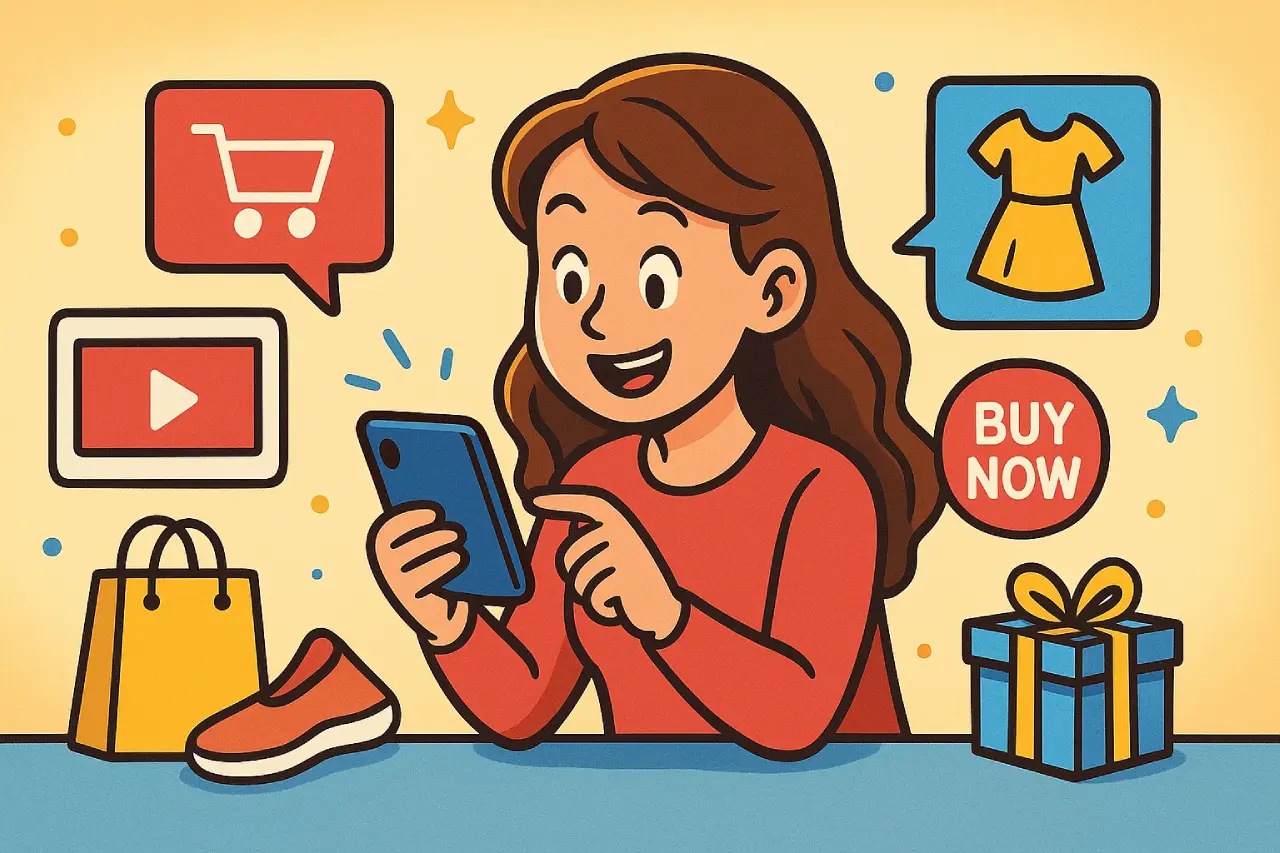A customer watches a video. A product catches their eye. Without a second thought, they tap and buy it. This isn’t magic. It’s the powerful psychology of impulse buying in action—and it accounts for 40-80% of all purchases across various product categories.
For e-commerce professionals, this spontaneous behavior represents a massive revenue opportunity. Understanding the “why” behind impulse buying allows you to strategically create the “how.” This is where modern video commerce doesn’t just sell—it connects on a deeper, psychological level to drive conversions.
Let’s unravel the mental triggers behind unplanned purchases. Then, we’ll explore how video commerce is uniquely designed to support and amplify these very instincts.
What is Impulse Buying: A Journey into the Consumer Mind
Impulse buying is an emotional, swift, and unplanned decision to purchase. It’s a powerful reaction, often bypassing our logical, deliberate thought processes. Neuroscientists link this behavior to the brain’s reward system. The anticipation of a reward—the new product—releases dopamine, creating a feeling of pleasure.
The traditional e-commerce model, however, is built for the logical brain. It introduces friction that stifles this emotional spark:
- See a product in a video.
- Leave the video to search for it.
- Find the correct product page.
- Read descriptions and reviews.
- Finally, add to cart.
At any of these steps, the dopamine fades. Logic kicks in. The window for impulse buying slams shut. In fact, the average e-commerce cart abandonment rate stands at 70.22%, often due to this very friction.
Video Commerce: The Perfect Psychological Partner
Video is inherently emotional. It tells stories, builds connections, and demonstrates value in a way static images cannot. Viewers retain 95% of a message when they watch it in a video, compared to 10% when reading it in text.
But standard video is a passive experience; it inspires desire but doesn’t fulfill it immediately. This creates what marketers call the “inspiration gap”—the distance between wanting something and being able to buy it.
Video commerce changes the game. It acts as the bridge between emotional spark and immediate action. It supports the psychology of impulse buying by creating a seamless, frictionless environment where desire can instantly become ownership. Implementation of shoppable videos can lead up to an 80% increase in conversion rates.
How Video Commerce Supports Key Psychological Triggers
Let’s break down the specific mental principles of impulse buying and see how video commerce directly supports each one.
1. Supporting the Need for Instant Gratification
The Psychology: The core of impulse buying is the craving for immediate reward. The brain wants the “feel-good” dopamine hit now, not later. This urgency is psychological—
60% of millennials make reactive purchases within 24 hours due to FOMO, especially when they see limited-time offers.
Shoppable videos place a “Buy Now” button directly at the moment of peak desire. The path to reward is shortened to a single tap. This instant accessibility is the ultimate support system for the need for immediate gratification. Furthermore, features like real-time inventory counters (“Only 3 left!”) amplify this urgency, making impulse buying the most natural response.
2. Amplifying Social Proof and Storytelling
The Psychology: We are influenced by seeing others use products. When we see an item in a realistic context, it becomes more desirable and less risky, lowering our mental barriers.
74% of consumers trust user reviews as much as personal recommendations.
Video commerce showcases products in authentic situations—a model wearing an outfit, a chef using a gadget. This is social proof at its most powerful. By allowing users to purchase the exact item from the scene that convinced them, video commerce directly supports the trust-building that impulse buying relies upon. Additionally, Viewers engaged with shoppable videos show a 9x increase in purchase intent.
3. Reducing Friction and Decision Fatigue
The Psychology: Too many choices or a complicated process can overwhelm the brain. This “decision fatigue” causes hesitation and allows logic to override emotion, killing the impulse. 48% of customers abandon carts due to extra costs, while 24% abandon due to mandatory account creation.
A shoppable video simplifies the journey dramatically. It guides the viewer’s focus and integrates the checkout process into the experience. By minimizing clicks and cognitive load, video commerce supports a state of flow where impulse buying can happen effortlessly. Moreover, this streamlined approach can reduce the number of steps to purchase from 5+ to just 1 or 2, effectively capturing the impulse before it fades.
The Direct Impact on Business Metrics
The psychological advantages of video commerce translate into tangible business results. While specific claims about 18% AOV increases need verification, businesses implementing video commerce strategies see substantial improvements. E-commerce brands using live video shopping events see a 32% higher repeat purchase rate than those using static product launches.

For example, a fashion brand can showcase a complete outfit in a video. When a customer clicks to buy the dress, they see matching shoes and accessories suggested right there in the player. This contextual cross-selling takes advantage of the impulsive mindset, leading to larger basket sizes.
Building Your Video Commerce Strategy for Impulse Sales
Understanding the theory is the first step. Applying it is what drives revenue. Here’s how to build a video commerce strategy that actively supports impulse buying.
1. Create Content That Triggers Emotion
Your video content should focus on storytelling and emotional connection rather than just product features. Use a studio for content creation to produce professional-quality videos that show your products solving real problems or enhancing lifestyles. Create “day-in-the-life” scenarios, tutorials, or styling sessions that naturally showcase multiple products together.
2. Ensure Seamless Technical Integration
The technical foundation must be invisible to the user. Use a platform with deep WordPress & Shopify integration to ensure your shoppable videos feel like a native part of your store. The easier it is to implement and manage, the more quickly you can test different approaches to triggering impulse buying.
3. Maintain Real-Time Product Accuracy
Nothing breaks the impulse spell faster than inaccurate information. Implement robust product integration with e-commerce platforms to ensure pricing, variants, and inventory levels are always current. This builds the trust necessary for spontaneous purchases and prevents the frustration of clicking on unavailable items.
4. Leverage Your Media Assets Strategically
Organize your visual assets in a centralized media library for easy access and consistency. This allows you to quickly assemble new video combinations based on what’s working. A well-organized library enables rapid testing of different psychological triggers to see what best drives impulse buying for your specific audience.
5. Measure What Actually Drives Impulses
Use advanced analytics to track which video moments lead to clicks and purchases. Go beyond basic view counts to understand metrics like product views within videos, heatmaps of engagement, and purchase location data. This intelligence helps you refine your content to trigger impulse buying behaviors better.
Real-World Success Patterns
Companies that have mastered this approach show consistent patterns. Beauty brands use tutorial videos where every product used is immediately purchasable. Home goods companies show room makeovers with clickable furniture and decor. Fitness brands demonstrate equipment use while offering the items for instant purchase.
The common thread? They’re not just selling products—they’re selling solutions and lifestyles. And they’re making those solutions immediately obtainable at the exact moment the customer feels the desire.
Conclusion: From Understanding to Execution
Impulse buying is not a random event. It is a predictable psychological pattern driven by emotion, social cues, and the desire for instant reward. With video marketing achieving conversion rates that match or surpass other content formats for 93% of organizations, the opportunity is too significant to ignore.
Video commerce is the ultimate tool for supporting this pattern. It doesn’t just show a product; it creates an immersive, low-friction environment where the psychological triggers of impulse buying can flourish.
By marrying the science of the mind with the art of video, you can transform passive viewers into spontaneous buyers. You move beyond hoping for impulses to systematically supporting them, building a more profitable and psychologically attuned e-commerce business. The data is clear, the psychology is proven, and the technology is here. The only question is: will you leverage it?

